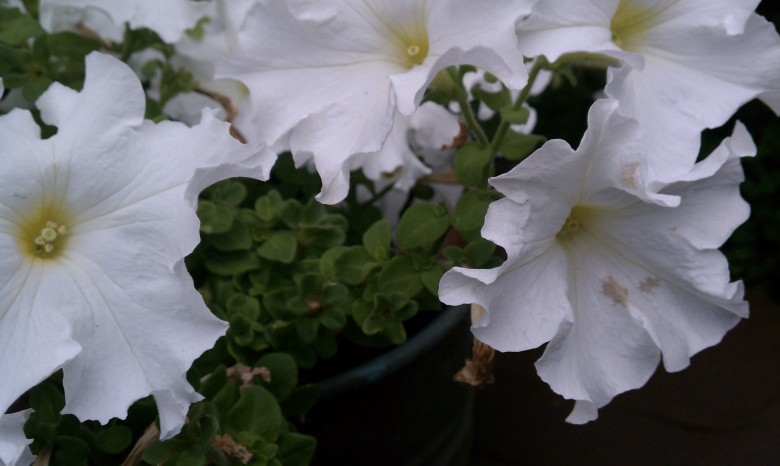Petunias, ya either love ’em or hate ’em. When I was a kid petunias were big flowers offered in a handful of colors: red, white, purple and pink, or at least that’s what I remember. My mom used to plant them in our window box on the front of our house every year. I remember watching them grow from little mounds of color to flowers overflowing from the box later in the summer.
For me, petunias have a bit of nostalgia. Add the lovely scent of the grandiflora petunias (the big flowers, reminiscent of a twirling gown) to the childhood memories and petunias do a little tugging on my heart-strings. But petunias get a bad rap in many parts of the green (as in plant) industry. They complain that they get long and scraggly if you don’t prune them. They get seed pods and tiny seeds all over and they “burn out” in the summer. For many they just aren’t cool enough. So people have been working to perfect the petunia, because, well a lot of people love petunias. So they came up with newer versions: along came plants that didn’t require pruning, flowers of any size from large to tiny and loads of new colors, but something was lost along the way: that sweet summer scent.
Are there some fun, new petunias? Sure. Can you match them to your garden or home decor? Practically. And while I like those just fine, there’s something to be said for the “old-fashioned” large blossomed, sweetly scented petunia. And if you love them, or even just kind of like them, here is a super simple tip on keeping your old-fashioned (grandiflora) petunias lush and blooming all summer long.
Petunias grow and bloom from the base of the plant out toward the end of the stem. As petunias continue to grow and bloom the plant is busy working behind the scenes on setting seed so it can complete its life cycle (die). If petunias are left to just take their natural course, they will continue blooming at the tip of the stem, but the rest of the plant will look long, spindly and frankly pretty ratty. That will go on until the plant decides it has set enough seed to be able to have at least one plant grow up and continue the family name, in which case it will then die. However, if you were, instead, to prune off the spent blossoms (those that have finished) all the way back to the stem, another set of leaves and blossoms will be ready and waiting to take their turn filling out and blooming, leaving you with a full, lush blooming plant. Let’s take a peak as to how to do this, shall we?

Here we see our lovely petunia with her large ruffled flowers. Behind those flowers you can see tan-colored spent blossoms, about to drop. And if you look further behind, you’ll see a slightly shiny, tan, conical-shaped seed pod.

Here we are a little closer. We snuck behind the blossoms so you can see what we are about to prune. In this picture you can see two spent blossoms, one mature seed pod and one seed pod just starting to emerge from a blossom that has recently fallen off. We will pinch or prune these back to the stem with a small (bypass) pruners or even just our fingernails. You will find that pruning petunias is sticky business. Nothing too repulsive, but it will leave your fingers a bit tacky.

This is our pruned stem. Notice that the old blossoms and seed pods have been removed exposing the new set of leaves and buds to begin blooming. Keep on top of this throughout the season and you will have lush petunias all summer long.
But wait! What if your plant is already long and leggy? Is it too late? Not at all. In this case you would want to cut the main stem back about a third (or so) to force the plant to fill out instead of continuing to get longer. The down side of this is that your plant will appear to have gotten a haircut for a while and won’t have blossoms on it for a couple of weeks while it puts its energy back into green growth and new buds, but the upside is that you will have lovely petunias again in a couple of weeks. If you don’t have the heart to chop back the entire plant at once or you want to sneak in the pruning, you could always do it in stages by trimming a few stems one week, a few stems the next week and so on. If, however, we were were nearing the end of summer, the plant had gotten really leggy and the side stems, where the blossoms once sat, look and feel more like dead twigs than a green plant, and if the seed pods have all dried and popped open, then the plant has probably already reached the point of no return, in which case pruning may be ineffective.
But summer is nowhere near over yet, so get out there and pinch those petunias! And while you’re at it, don’t forget to stop and smell the… blossoms of course!
Kate